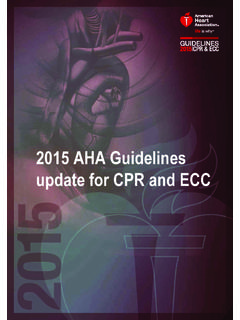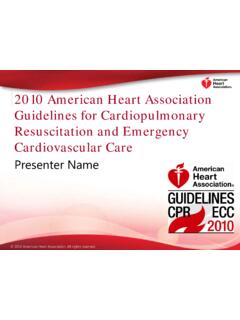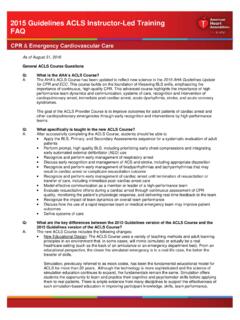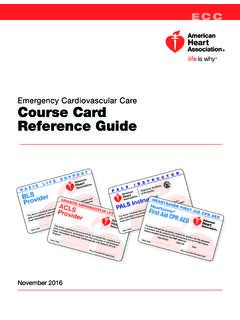Transcription of Immediate Post-Cardiac Arrest Care Algorithm - ACLS
1 Follow Commands ?Version control: This document follows 2020 American Heart Association guidelines for CPR and ECC. American Heart Association guidelines are updated every ve years. If you are reading this page after December 2025, please contact for an update. Version your ACLS recerti cation online with the highest quality course at ACLS Training Center+1 of Spontaneous Circulation (ROSC)*Optimize Ventilation and OxygenationTreat Hypotension (SBP < 90 mm Hg)Maintain oxygen saturation >92% 98%Consider advanced airwayWaveform capnographyDo not hyperventilateIV/IO bolusVasopressor infusionConsider treatable causes12-lead ECGT argeted Temperature Management**Advanced Critical CareDoses/DetailsVentilation/Oxygenation Avoid excessive ventilationStart at 10 breaths/minand titrate to target PETCO2 of 35 40 mm HgWhen feasible, titrate FIO2 to minimum necessary toachieve SpO2 92% 98%IV Bolus1 2 L normal saline orlactated Ringer sIf inducing hypothermia.
2 May use 4 C uidEpinephrine IV Infusion2 10 mcg per minuteReversible CausesHypovolemiaHypoxiaHydrogen ion (acidosis)Hypo-/HyperkalemiaHypothermiaT ension pneumothoraxTamponade, cardiacToxinsThrombosis, pulmonaryThrombosis, coronaryDopamine IV Infusion5 20 mcg/kg per minuteNorepinephrine IV mcg/kg per minute(in 70-kg adult: 7 35 mcgper minute)* Sasson C, Rogers MA, Dahl J, Kellermann AL. Predictors of survival from out of hospital cardiac Arrest : a systematic review and metanalysis Circ Cardiovasc Qual Outcomes. 2010;3:63-81.** Bruel C, Parienti JJ, Marie W, Arrot X, Mild hypothermia during advanced life support, a preliminary study in out of hospital cardiac Arrest .
3 Crit care . 2008;12: R31** Callaway CW, Donnino MW, Fink EL, Geocadin RG, Golan E, Kern KB, Leary M, Meurer WJ, Peberdy MA, Thompson TM, Zimmerman JL. Part 8: Post-Cardiac Arrest care : 2015 American Heart Association Guidelines Update for Cardiopulmonary Resuscitation and Emergency Cardiovascular care . Circulation 2015;132(suppl2):S465-S482If STEMI is present Unstable cardiogenic shockCircultory support requiredCardiac Catheterization LaboratoryCT brainCardiac monitoringAdvanced critical careImmediate post -CardiacArrest care Algorithm











